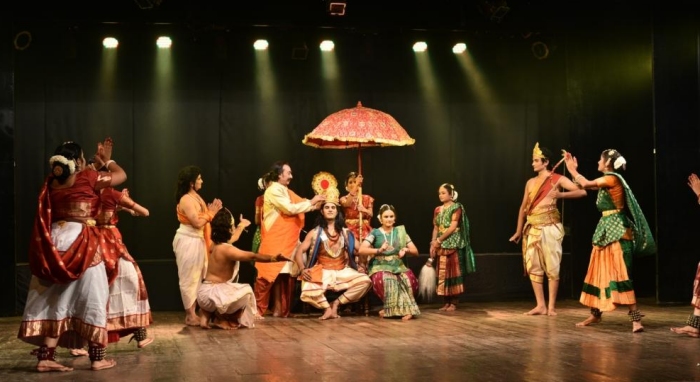
|   |

|   |
A quiet flow of bhakti in Shree Ramanaatakam - Dr. S.D. Desai e-mail: sureshmrudula@gmail.com September 30, 2017 Krishna is said to be poornapurusha. Protecting, pragmatic and shrewd, he can get naughty and romantic, too. Reticent, unlike Krishna, and inhibited by moral considerations, Ram is traditionally regarded as maryadapurushottama. While episodes involving the former have been presented over the years dramatically more often, those with the latter in the centre have inspired more poetic works. Carrying Bhakti Rasa suits poetry. In the dance drama Shree Ramanaatakam, Dolly Desai's Bharatakalanjali presented in the H. K. Auditorium last Tuesday, even in the midst of dramatic episodes, it's a quiet flow of Bhakti through poetry that dominates in it.
Poetry, with its dhwani, was already there in the source, in the chaupais, chhands and duhas of Saint Tulsidas's Ramcharitmanas, a popular Hindi/Avadhi version of Valmiki's original in Sanskrit. They recited with utmost humility and ease. The pithiness of the lines did not go unnoticed. Dolly Desai, with subtle felicity, enriches the poetry with visual suggestion in a classical dance style. She also gets Niraj Parikh, a senior disciple of Pt Jasraj, to adorn it with his musical score rich in delectable vocal recitals and instrumental and rhythmic patterns. And, when she steps in as a performer, insightfully does she draw from Bharatanatyam's inexhaustible repertoire of intricate facial expressions and mudras, the former including netrabhinaya, and develops a nonverbal dialogue - when with King Dasharath as Kaikeyi, for example. Exhilaratingly are single instruments - string or percussion - in tune with them. The music provides cues to the young dancers still learning the dance form as well to respond to it now with joyousness, now energy, now playfulness, taking minor flaws in their stride. All this, and much more, is made possible by Dolly Desai Thakkar, who has conceptualized the ninety-minute drushya-shravya piece keeping its kavit intact. With surprising finesse - this is perhaps her best production - she selects core episodes, then visualizes and coordinates them. She makes bold, at not exactly a young age, to play roles of Kaushalya, Kaikeyi and Shoorpanakha, to mention the major ones, and play them pretty well. Bhargav Thakkar dramatically as Sutradhar in direct communication with the viewers keeps explaining significance of the episodes, and prepares them for what is to follow and gives time to the performers backstage. A young Shivankar, specially invited from Ayodhya, portrays Ram well. Ram's elevated projection, initially on a raised platform in the deep, paired with Seeta following swayamvara, in heroic action and in a benign demeanour as the narrative progresses is strikingly studied. A bit girlish in her` looks, Akanksha as Seeta emerges as his constant companion. In cameo roles, locally known performers decorate the Katha flowing on in a classical format with portrayals of two characters in familiar folk styles. Combining elements of the classical and the folk, with free abandon, Jignesh dances in front of Ram during his journey to the forest on lines of a noted Gujarati devotional poet Dula Kag, Pag mane dhova dyo ne... ('Let me wash your feet, Raghurai...'). Kalarav, an actor, made-up convincingly, brings to life a valiant battle Jatayu fought against Ravana (Manoj) to save Seeta. Trijata's Suno Seeta maat... is another Gujarati song used. Lights (Parth) in these scenes, as elsewhere, enhance verisimilitude.  Details in carefully culled excerpts from the seven sections of Tulsi Ramayan and occasional interpretative observations by the Sutradhar make it a pleasure to be audience to the Naatakam. Young dancers endearingly emulate movement of animals and flowers, simulate playing the sitar, the shehnai, the mridanga, and express joy and devotion as the common people. It is heartening to see that there is a discerning attempt in the production to address the modern sensibility. Bhakti is interpreted as a means for the Jeevatma to swim across the ocean of this life and be one with the universal consciousness. The desire for suvarna mriga is explained as a shared human craving for material possessions. And, the subject expert Vijay Pandya has prompted the team to stress Hanuman's sacrifice besides dedication in drowning the script of the Ramayan he himself had written so that Valmiki's would be read and heard with undivided attention. Dr. S.D. Desai, a professor of English, has been a Performing Arts Critic for many years. Among the dance journals he has contributed to are Narthaki, Sruti, Nartanam and Attendance. His books have been published by Gujarat Sahitya Academy, Oxford University Press and Rupa. After 30 years with a national English daily, he is now a freelance art writer. |